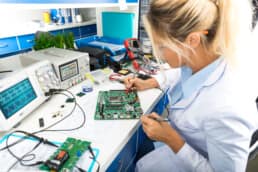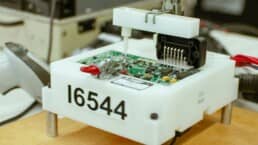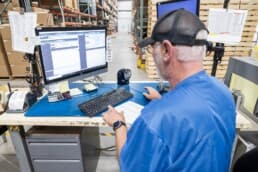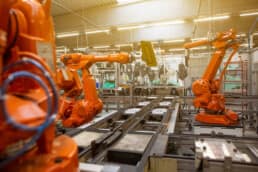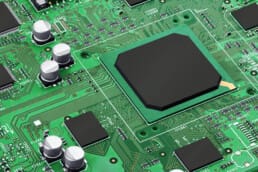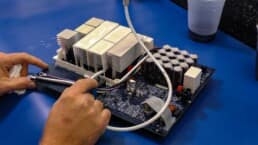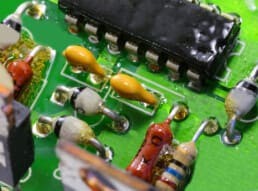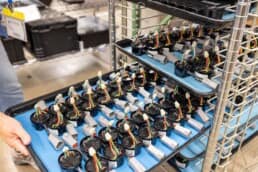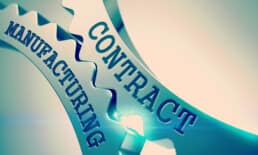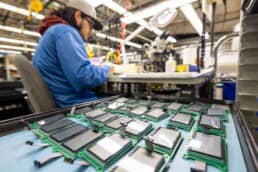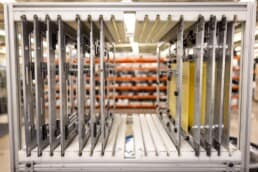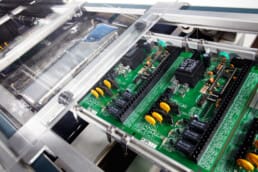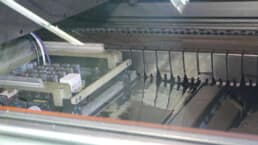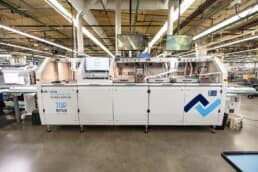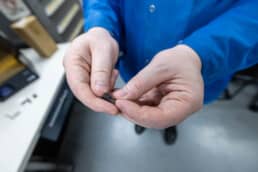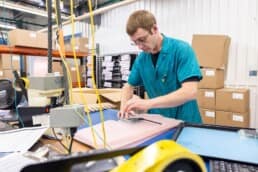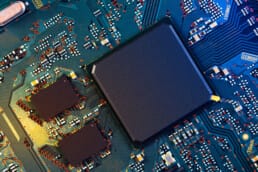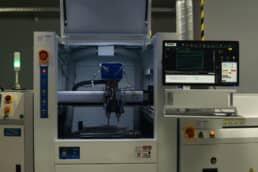The Most Common Causes of PCB Failure
Nothing is 100% perfect 100% of the time. Because of this, the best manufacturers design their systems to examine the failure modes thoroughly when they happen. This allows them to trace them back to a root cause and eliminate those failures. When we talk about printed circuit board (PCB) failures, there are two distinct types to consider. There are failures during the design-build-test cycle and failures during service. Of course, the customer is only concerned about failures in service. However, to minimize these, we often need to create failures during the design-build-test cycle. This will identify weaknesses and shore them up before the product design is ready for production. RiverSide Integrated Solutions (RIS) provides full-circuit board and electromechanical assembly with testing capabilities. We can develop and test circuit board inspection and testing schemes to ensure the product performs well. We can perform PCB assembly (PCBA) testing, system-level integration testing and thermal/mechanical stress testing. Whatever your requirements, we can ensure it works properly. All of this adds up to a robust manufacturing process and high reliability in service. If we look at the manufacturing process first, there are a couple of things that can show up. If your application requires a multi-layer board, the alignment from layer to layer is critical. There are often vias (small conductive channels that act as conductors) between layers. It’s easy to imagine how a misalignment between layers can lead to a short or open circuit. Misalignment is also a critical process for the placement of components. They can be as small as a fraction of a millimeter in size. Suppose you add in the small area available for solder placement. In that case, solder bridges (shorts) or open circuit conditions can occur. Fortunately, at RIS we use an automated handling system for PCBAs with a fully Automated Optical Inspection (AOI) system. This system rapidly takes snapshots at various stages of assembly. It compares critical real-time parameters such as solder coverage and component placement before moving the board to the next level. As a result, we eliminate manufacturing errors before the board goes to the next step. That means they seldom appear in the finished board assembly. We can offer a functional, custom, end-of-line tester in certain instances. These testers would power up the board, inject appropriate signals into the circuitry and measure the response. This would constitute a final or acceptance test before packaging and shipping. Although PCBAs are considered strictly electrical in function, they must also handle some surprisingly tough mechanical issues. One of the simplest to understand is the complications of mixing different materials. PCBAs have various materials in their makeup: copper, epoxy, solder, ceramics and plated metals. Each component expands when heated and shrinks as it cools. Everything on the board undergoes tens of thousands of cold-hot cycles during their lifetime, so everything must be tested. This includes all of the solder joints, attachment points, the laminations of the board and connectors. If the board is used outdoors, these temperature swings could easily be 100 ˚C for several days. Over time, these temperature-related stresses can lead to cracking and loss of proper electrical function. A common way to guard against this failure mechanism is by burning-in boards. This test subjects a PCBA to a temperature regime that allows all components to “adjust” to temperature-related stresses. There are a couple of ways to do this, depending on the experience of the board designer. A high-temperate soak, often for 24 hours, performs an annealing process. This makes the PCBA much more immune to cracking later. Another approach is to have the boards cycle through temperatures from the lowest to the highest operating temperatures. This test gives the PCBA time to soak at both the cycle’s hot and cold ends. This is a more stressful thermal test and can weed out product at the very end of the bell curve. RIS can accommodate either type of thermal conditioning, depending on your needs. The other mechanical issue that a PCBA may have to endure is a high shock and vibration. This usually requires stiffening up the board through mechanical supports. Alternatively, the board can be mounted on shock absorbers to isolate it from the outside forces. Usually, either of these approaches is used with added epoxy around the heavier components to prevent them from loosening. The design can be validated against this vibration environment using standard “shock and vibe” test equipment and fixtures. As you can imagine, after such a thorough manufacturing process, most PCBAs are ready for a long service life. And you would be right – electrical assemblies are considered a highly reliable part of any system. At the same time, some products fail in service. Usually, when this happens, it is within the first few weeks, especially if the part is a replacement. There are many explanations for this, but we can illustrate with a simple example. For a correct replacement procedure, technicians must wholly replace old parts. The technician will begin by disconnecting old parts. They will then clean and inspect the board for cracking or wear and tear. Finally they will check electrical connections for continuity. If they don’t properly follow these steps, later service calls often find intermittent electrical connection issue or voltage drops. In retrofit situations, sometimes the power connector has been replaced. Here, it often becomes necessary to modify the replacement part to match the existing installation. Unfortunately, the power line often gets miswired, and the unit dies in a puff of smoke. These are usually honest mistakes. Well-meaning people try to solve a problem quickly and overlook a critical defect. Usually, a phone call to the technical support line before doing the replacement will weed these out. This saves everybody time in the long run. There are, of course, legitimate premature field failures that need to be treated seriously. Where RIS has the service contract, give us a call. We perform reverse logistics services for all of our customer’s needs. At RIS, PCB assembly is one of our core competencies. We provide reliable, seamlessly-assembled printed circuit board systems built with extreme precision. Our skilled engineers, technicians and assemblers work to expertly put together a complete PCBA. When you choose RIS, you can expect the hands-on customer care of a small operation with the capabilities characteristic of a larger company. We provide our complete electronics manufacturing services for OEMs in any industry. Our electronics assembly expertise includes:ELECTRICAL ISSUES
ELECTRICAL ISSUES
ALIGNMENT AND VIAS
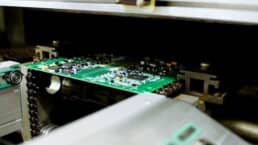
COMPONENT PLACEMENT
MECHANICAL ISSUES
THERMAL STRESSES
SHOCK AND VIBRATION
FIELD FAILURES
REPLACEMENT PROCEDURE
RIS PCBA EXPERTISE
About RiverSide Integrated Solutions
RIS is an advanced contract manufacturer providing robust solutions in circuit board assembly and product assembly. We employ more than 350 people and provide services to OEMs worldwide. We operate two state-of-the-art manufacturing facilities within the US.
With all of the choices in contract manufacturers out there, we know it can be challenging to find someone who understands your business model and has your best intentions in mind. RIS has always proven to be a win-win-focused relationship.
As your one-stop shop, we have the capabilities, capacity, quality assurance standards and resources to support all of your manufacturing needs. We understand that supply chain management is complex and very time-consuming, so we urge our customers to utilize us in the fullest capacity.
Our total-package solutions include:
- Extensive supply-chain network
- Full box-build assembly
- Dedicated Program Team
- Warehousing, kitting and drop-shipping capabilities
- Reverse logistics
- Flexible order fulfillment
- Scalability to meet your needs
Contact us today at (507) 523-3220 to see how we can help with your manufacturing project, or click contact us for a quote.
Increasing Efficiency In Reverse Logistics
When customers return a product because it’s not working correctly, it loses its value. The original equipment manufacturer (OEM) must retrieve and evaluate the defective product to understand what went wrong. This process is called reverse logistics. It’s important to have a process for customers to quickly and easily return the product. This helps reduce waste, improve production processes and make customers happier. It also allows technicians to give feedback to fix or enhance product design. Overall, having a good reverse logistics system adds value for customers. Many production processes are lengthy and complicated, with few opportunities for quality control. If the item produced fails, it can be hard to figure out what part of the process went wrong. That’s why specialized technicians handle reverse logistics. These technicians are trained to find out what went wrong and how to fix it. They use special tools and techniques to do this. Sometimes they even need to use the same equipment that made the product. But funding reverse logistics can be problematic for smaller OEMs. Many do not have the resources to handle returns. Instead, many outsource the process. This is where RiverSide Integrated Solutions (RIS) comes in. We are a contract manufacturer that helps other companies make and test products, especially electronics. We also offer several full-service options to our customers. OEMs can combine multiple services under our roof to save time and money. RIS can step in and ensure the process of returning products runs smoothly! To demonstrate, let’s look at our reverse logistics process. Many times, customers end up paying the freight for returns themselves. In an ideal situation, the customer would first call our reverse logistics facility. Then our experienced professionals can take down the information for their return in our system. We can also provide the customer with a return merchandise authorization (RMA) number. Once customer information has been collected, staff will record this information in a database. The database compares the information and comes up with possible explanations for failure. This cuts down on the amount of time staff needs to evaluate it. Once the item arrives, it is looked over by our specialized technicians. They record any problems with the product and maybe even recreate it to figure out what went wrong. For some products, they may be able to look at the product and immediately see what’s wrong. Other times, they might need to talk to the customer. This might reveal information about how they were trying to use it. Once our technicians identify the issue, they follow specific processes to ensure it doesn’t happen again. Most failures fall into one of two categories. Either the problem with the product occurred: We will fix or replace the product for free if the failure was a manufacturing mistake. If necessary, we will do our best to help the customer avoid future failures. We may explain why the product failed, how we fixed it and how to ensure it doesn’t happen again. We will also contact the OEM to adjust designs to resolve the issue for future production cycles. Alternatively, we can offer the customer a few choices when a product fails due to age or overuse. We can fix it for a fair price and within a reasonable time. If this isn’t what the customer wants, they can purchase a new product. Once the problem is resolved, we will return the product to the customer. Or, if the customer does not want the refurbished item, the OEM decides what to do with it. They might fix it, replace it, try to get some money back or throw it away altogether. Making the process of handling products easier has many benefits. It can save money, make customers happier and better utilize resources. This kind of service helps build trust and makes it easier for people to do business. It also allows OEMs to learn how to improve their products over time. All these benefits are worth more than the cost of putting the system in place. Implementing a good reverse logistics system can ultimately reduce the number of returns you receive. Looking at why a product failed leads to product improvements. This, in turn, helps reduce the number of failed units in the future. This means less money spent on fixing things and less time spent handling repairs. Ultimately, this can improve cash flow and add value to your business. It’s worth considering implementing a reverse logistics process to save time and money in the long run. And if your company can’t afford to implement these processes in-house, companies like RIS can help. When you hire us to do your manufacturing and reverse logistics, you save time and money! In most cases, even though a finished unit may have failed, it likely contains working parts. At RIS, we recover much of the cost of our reverse logistics process by reusing parts for fixes in the future. For anything that can’t be reused, we recycle or dispose of the materials responsibly. When something goes wrong with a product, OEMs must handle the return process smoothly and quickly. This can make a big difference in how customers perceive the company. Suppose a customer has a good experience returning a product. In that case, it shows that the OEM is trustworthy and cares about its customers’ satisfaction. Customers expect returns to be simple and hassle-free. Treating them well during returns can positively impact the company’s reputation. When people have a good experience, they share it with others. Remember, every interaction is important for building brand reputation! Realistically, customers return things for a myriad of reasons, not just because of product failures. But reverse logistics is important, regardless of why the product was returned. It can help identify numerous types of trends surrounding a product’s lifecycle. That’s why you want your reverse logistics and manufacturing processes paired. Monitoring these two processes in conjunction makes it easier to catch issues early on. Doing this can reduce the number of returns and make the process more efficient. At RIS, we understand how vital good reverse logistics is. That’s why we offer this service to our clients who already use our manufacturing services. We have a dedicated team that handles our reverse logistics process. They ensure everything is done smoothly without impacting the production of other products. Contact us today to learn how RIS can help you with reverse logistics. Our team of consultants can review your project and develop the right strategy for your goals. With our highly qualified team, you can be sure you’ll get great value for your reverse logistics needs. We would love to be your trusted partner!WHY COMPANIES NEED REVERSE LOGISTICS
RETURNS
INITIATING CONTACT WITH THE CUSTOMER
DETERMINE THE FAILURE MODE
RESPONDING TO THE FAILURE MODE
BENEFITS TO REVERSE LOGISTICS
RESOURCE UTILIZATION
RECOVERING COSTS
CUSTOMER SATISFACTION AND RETENTION
TRANSPARENCY
About RiverSide Integrated Solutions
RIS is an advanced contract manufacturer providing robust solutions in circuit board assembly and product assembly. We employ more than 350 people and provide services to OEMs worldwide. We operate two state-of-the-art manufacturing facilities within the US.
With all of the choices in contract manufacturers out there, we know it can be challenging to find someone who understands your business model and has your best intentions in mind. RIS has always proven to be a win-win-focused relationship.
As your one-stop shop, we have the capabilities, capacity, quality assurance standards and resources to support all of your manufacturing needs. We understand that supply chain management is complex and very time-consuming, so we urge our customers to utilize us in the fullest capacity.
Our total-package solutions include:
- Extensive supply-chain network
- Full box-build assembly
- Dedicated Program Team
- Warehousing, kitting and drop-shipping capabilities
- Reverse logistics
- Flexible order fulfillment
- Scalability to meet your needs
Contact us today at (507) 523-3220 to see how we can help with your manufacturing project, or click contact us for a quote.
The Benefits of Outsourcing
When Outsourcing Makes Sense
As manufacturing organizations grow and change, they need to be able to assess their operations’ efficiency continually. As a result, it’s not unusual that, at some point, companies of all sizes will need to decide whether they should invest in a new (or upgraded) operation on-site. Otherwise they will end up outsourcing that function.
Many different functions could be under consideration: mechanical assembly, machining and printed circuit board assembly (PCBA) are typical examples where the opportunity for outsourcing deserves careful consideration.
Core Competencies
At some point, companies must decide whether manufacturing represents a core competency of the company or if it can be more economically outsourced.
One example may be that the company has a process of taking in cast aluminum parts and then performing a machining operation to “clean-up” the castings using a lathe. They also pre-drill some attachment points using a drill press. Given today’s modern CNC machining operations and multi-axis equipment with tool changers, it probably makes sense to have a contract manufacturer perform that task.
In addition, teaming up with a contract assembly partner enables original equipment manufacturers (OEMs) to tap into years of know-how and expertise. Contract manufacturers often have decades of experience with various products and industries.
At RiverSide Integrated Solutions (RIS), product assembly solutions can include building subassemblies ready for installation into higher-level assemblies. Other options include building complete products start-to-finish. In addition, our experience allows us to provide insights and recommendations that add value for our customers.
IDENTIFYING CAPABILITIES
While considering the merits of outsourcing, it is vital to be clear about the expectations you have for a contract manufacturer to bring to your operation. Putting together a “Minimum Requirements” document is often the most helpful way of evaluating potential partners. This in-house assessment of expectations for the deliverables and capabilities of a contract manufacturer will help you make fair comparisons between candidates. This document should also allow for the flexibility to consider capabilities or techniques where your company may not have expertise.
Take, as an example PCBAs. A company like RIS, which specializes in PCBAs, might suggest an approach you had yet to consider. Flexibility would allow you to consider these alternative approaches between competing suppliers.
Industry Specialization
It is also helpful to know whether a contract manufacturer works in particular industries. Suppose they are already familiar with the baseline requirements of the industries you currently serve. In that case, they may be a better fit for your company. They may also have insight into adjacent industries that you could be considering for expansion.
RIS is an example of an integrated manufacturer. We execute multiple supply chain steps, including manufacturing assembly, kitting, distribution and fulfillment. Integrated manufacturers offer significant value for OEMs, such as streamlining production schedules, improving the consistency and reliability of the final product and minimizing the number of vendors.
IT'S NOT ALL ABOUT THE COST
Switching to contract manufacturing almost always results in cost savings, but not all paybacks are strictly monetary. In addition, gaining access to markets, improved technology or even a shorter lead time are desirable outcomes. Therefore, it’s important to consider everything that a contract manufacturer brings to the table that might benefit your business.
Choosing Experience
Outsourcing part of your business may seem risky at first, but understanding why you should do it and establishing your expectations for doing so will go a long way toward making the transition easy. Luckily, plenty of contract manufacturers, like RIS, have the experience and knowledge to help you make the right choice for your company.
About RiverSide Integrated Solutions
RIS is an advanced contract manufacturer providing robust solutions in circuit board assembly and product assembly. We employ more than 350 people and provide services to OEMs worldwide. We operate two state-of-the-art manufacturing facilities within the US.
With all of the choices in contract manufacturers out there, we know it can be challenging to find someone who understands your business model and has your best intentions in mind. RIS has always proven to be a win-win-focused relationship.
As your one-stop shop, we have the capabilities, capacity, quality assurance standards and resources to support all of your manufacturing needs. We understand that supply chain management is complex and very time-consuming, so we urge our customers to utilize us in the fullest capacity.
Our total-package solutions include:
- Extensive supply-chain network
- Full box-build assembly
- Dedicated Program Team
- Warehousing, kitting and drop-shipping capabilities
- Reverse logistics
- Flexible order fulfillment
- Scalability to meet your needs
Contact us today at (507) 523-3220 to see how we can help with your manufacturing project, or click contact us for a quote.
Comparing Conformal Coating vs. Potting/Encapsulation
In today’s dynamic electronics landscape, manufacturers face a dual challenge. They must meet the demands for smaller, more powerful devices while ensuring the ruggedization and durability of components in challenging conditions. This is particularly true for printed circuit board assemblies (PCBAs) used in industrial, machining and control applications. These critical components often encounter harsh environments, including chemical exposure, dust, electromagnetic interference and physical shocks. At RiverSide Integrated Solutions (RIS), we understand the paramount importance of ruggedization in PCBAs. Our multi-system approach allows us to tailor the degree of ruggedization to each product’s unique needs, providing a precise level of protection where it matters most. In this article, we’ll explore the various degrees of ruggedization, from conformal coating to potting and more, that can transform standard PCBAs into resilient mechanisms ready to thrive in the toughest conditions. Additionally, we’ll delve into advanced techniques, such as 3D printing and low-pressure molding. By the end, you’ll understand why RIS stands as a pioneer in automating PCB assembly while prioritizing ruggedness. Investing in automation also allows for the economical production of PCBAs for small to medium-sized electronics manufacturers. These assemblies often go into industrial, machining and control applications. Some reasons they require ruggedization are exposure to chemicals, dust, electromagnetic interference, shock and vibration. RIS has invested in a multi-system approach that tailors the degree of ruggedization to the product. We provide an appropriate level of protection in the vulnerable areas of the board assembly. Among our capabilities are: Most PCBAs can benefit from some degree of ruggedization. Imagine the intended application and all the steps the board will go through. From shipment to unboxing, assembly and connection, the opportunities are endless! Considering all of that, it may make sense to opt for at least basic protection against moisture intrusion. A spray-on silicone conformal coating on both sides of the board usually provides this. The result is a very thin waterproof layer that fills in the gaps between the board and components. Doing this dramatically reduces the probability of moisture intrusion and corrosion. Conformal coating is one of the most straightforward protections to apply while affording a much-improved protection against the elements. Suppose the intended operation of the PCBA includes exposure to temperature extremes, dust, dirt, chemicals, vibration or water. In that case, the design likely requires a higher level of protection. Encapsulation or potting is the next level. Though the terms are often used interchangeably, encapsulation is not the same as potting. In general, encapsulation is less extensive and intended to protect specific areas of the board. One everyday use for encapsulation is the protection of specific components. Especially if components are large, they are vulnerable to shock and vibration. Localized protection of these “heavy” components ensures they can withstand higher levels of shock. RIS offers both silicone and urethane encapsulation for PCBs that we manufacture. We use a weight monitoring system to ensure the correct dispensation of the encapsulant. This ensures efficiency and accuracy. The most common adhesives used for encapsulation are silicone or acrylic. These materials can be heat-cured or even UV-cured and are stable and inert. Suppose we take the step up from an encapsulant to potting. In that case, this usually implies a large area up to and including the whole board. Potting generally aims to seal the electronics against extremes of exposure completely. In an agricultural application, for example, the equipment could be used in the hot sun all day. It is also more likely to be exposed to dust and chemicals. At the end of the day, it may undergo a high-pressure washdown. This would be a typical use case for a potted board. Marine use also commonly requires potted PCBAs due to continuous exposure to wet environments. Potting compounds are often two-part epoxies that may undergo a heat cure. So far, we’ve introduced conformal coating, encapsulation and potting. All of these are done with various silicones or epoxies to add degrees of ruggedness to electronic boards. Some PCBAs have hybrid connections (both solder and wire bond). Protecting the wire bonds in those cases is important since they can be very fragile. The most common approach to ruggedization is to use silicone as an encapsulant. This stabilizes the bonds and reduces any stresses between the chip and the bonding posts. A unique capability we offer at RIS is using a hot-melt extruded filament under robotic control. This is a lot like a 3D printer. We utilize this precision technique to add vibration and shock resistance to specific areas of the board. One final element worth mentioning, though it is related to ruggedness in a more peripheral way, is 3D-printed tooling. Often, board space is at a premium. The solution is to place components as close together as possible but without interference. Along with this, the spacing has to be adequate to allow any encapsulants to flow. RIS has developed 3D fixturing that does the job. Taking time to produce custom fixtures allows tighter designs without compromising ruggedized areas. Low-pressure molding is another protective process. At RIS we call this machine the Mold Man. As the name implies, the machine molds a plastic coating around the PCBA. This encloses the components and protects the completed assembly completely. We fill the mold within a range of 30 to 300 PSI to ensure consistent molding. Only a few contract manufacturers have committed to automate PCB assembly for delivery as RiverSide has. RIS has thoughtfully added automation, inspection and manufacturing controls to our processes, where they will have the greatest impact. This benefits the quality of the product and improves yields. We also have the experience to advise your design team when some ruggedizing will benefit your designs.RUGGEDIZING PCBAS
DEGREES OF RUGGEDIZATION
STEP IT UP A NOTCH
THE NEXT LEVEL
SPECIAL CONSIDERATIONS
PUTTING IT ALL TOGETHER
About RiverSide Integrated Solutions
RIS is an advanced contract manufacturer providing robust solutions in circuit board assembly and product assembly. We employ more than 350 people and provide services to OEMs worldwide. We operate two state-of-the-art manufacturing facilities within the US.
With all of the choices in contract manufacturers out there, we know it can be challenging to find someone who understands your business model and has your best intentions in mind. RIS has always proven to be a win-win-focused relationship.
As your one-stop shop, we have the capabilities, capacity, quality assurance standards and resources to support all of your manufacturing needs. We understand that supply chain management is complex and very time-consuming, so we urge our customers to utilize us in the fullest capacity.
Our total-package solutions include:
- Extensive supply-chain network
- Full box-build assembly
- Dedicated Program Team
- Warehousing, kitting and drop-shipping capabilities
- Reverse logistics
- Flexible order fulfillment
- Scalability to meet your needs
Contact us today at (507) 523-3220 to see how we can help with your manufacturing project, or click contact us for a quote.
Why the Skills of Your Contract Manufacturer Matter
One of the critical elements of working with a contract manufacturer is to match their skill set to your particular needs. Often, the certifications, training and experience that a contract manufacturer has shaped the specific skills that a contract manufacturer brings to their craft. As a result, each contract manufacturer will have a unique imprint on the work they deliver. That is where the differences lie. And it’s crucial to closely assess these differences to be sure you’re getting the skillset that best fits the jobs you need done. When you have decided that you would like a particular subassembly to be manufactured outside of your plant, one of the first things to find out is whether or not your candidate contractor has done this type of work before. While it is rare that a supplier has made precisely the same deliverable (whether software or hardware) before, they likely have done something similar. It’s up to you to assess if their experience is similar enough to translate to your project. Make sure you closely analyze what each contract manufacturer brings to the table before making your decision. You can tell a lot about the capabilities of a contract manufacturer by looking at the pieces of capital equipment they have invested in. The more invested a company is in specific industries, the more vertically integrated they are likely to be. For example, at RiverSide Integrated Solutions (RIS) we have targeted printed circuit board assembly (PCBA) as one of our areas of expertise. As a result, our potential customers will expect that we have pick-and-place equipment, the ability to produce RoHS-compliant electronic assemblies and a way to encapsulate board assemblies. All are standard in-house equipment. You should also look at what a contract manufacturer invests in that goes above and beyond the standard. RIS invests heavily in staying at the cutting edge of technology for PCBA. We have state-of-the-art selective soldering machines, Smart Shelving and X-Ray Reel Counter. Suppose your project requires specialized equipment critical to producing a reliable part. In that case, you should ask where and how they intend to make that part for you. You can tell a lot about the capabilities of a contract manufacturer by looking at the pieces of capital equipment they have invested in. The more invested a company is in specific industries, the more vertically integrated they are likely to be. For example, at RiverSide Integrated Solutions (RIS) we have targeted printed circuit board assembly (PCBA) as one of our areas of expertise. As a result, our potential customers will expect that we have pick-and-place equipment, the ability to produce RoHS-compliant electronic assemblies and a way to encapsulate board assemblies. All are standard in-house equipment. You should also look at what a contract manufacturer invests in that goes above and beyond the standard. RIS invests heavily in staying at the cutting edge of technology for PCBA. We have state-of-the-art selective soldering machines, Smart Shelving and X-Ray Reel Counter. Suppose your project requires specialized equipment critical to producing a reliable part. In that case, you should ask where and how they intend to make that part for you. Suppose you are contracting out for a subassembly. In that case, chances are one of the reasons is that you don’t have the capability or resources in-house to produce the assembly economically in the volumes needed. You will want to ensure you understand their experience in doing this, how they plan to make this transition and the rate at which they can ramp up your product. The bottom line, ultimately, is how well the prospective contract manufacturer’s skills, experience and equipment match your needs. The old saying goes that you hope the finished product will be well-made (good), delivered on time (fast) and not too expensive (cheap), but you only get to choose two out of the three. Though there may be some truth to that, in today’s world of contract manufacturing, there are generally enough skills and experience available that you should be able to balance all three. If you’re smart about your search and diligent in vetting the prospective contract manufacturers, you can find your way to a happy conclusion.Work Experience
Skill with Specialized Equipment
Problem Resolution Experience
Skills in Ramping Production
The prospective new supplier is likely to invest in specialized tooling only once they produce an initial proof (or more if the contract calls for it) and it gets approved. Then, once all parties are happy with the supplied part(s), the contract manufacturer will build the necessary tooling.The Bottom Line
About RiverSide Integrated Solutions
RIS is an advanced contract manufacturer providing robust solutions in circuit board assembly and product assembly. We employ more than 350 people and provide services to OEMs worldwide. We operate two state-of-the-art manufacturing facilities within the US.
With all of the choices in contract manufacturers out there, we know it can be challenging to find someone who understands your business model and has your best intentions in mind. RIS has always proven to be a win-win-focused relationship.
As your one-stop shop, we have the capabilities, capacity, quality assurance standards and resources to support all of your manufacturing needs. We understand that supply chain management is complex and very time-consuming, so we urge our customers to utilize us in the fullest capacity.
Our total-package solutions include:
- Extensive supply-chain network
- Full box-build assembly
- Dedicated Program Team
- Warehousing, kitting and drop-shipping capabilities
- Reverse logistics
- Flexible order fulfillment
- Scalability to meet your needs
Contact us today at (507) 523-3220 to see how we can help with your manufacturing project, or click contact us for a quote.
Meeting and Exceeding Manufacturing Expectations Through Quality Control
Design for Manufacturing (DFM) is designing products for easy manufacturing and creating a better, more cost-effective product. Making a product that works well and lasts a long time takes a lot of work. One important step is ensuring the design is as simple and efficient as possible. This helps the product work well during production and when people use it. DFM aims to reduce manufacturing costs and avoid costly disruptions without sacrificing quality or performance. DFM is part of a way of making things that tries to do it right the first time. This helps to use fewer materials and not repeat steps, saving time and money. Adopting the DFM approach can help original equipment manufacturers (OEMs) save money and time. It improves how things are done and speeds up the process of getting products to market. This is especially helpful for contract manufacturers. At RiverSide Integrated Solutions (RIS), we help our customers maximize the manufacturability of their designs. Our dedicated quality improvement team aims to improve our manufacturing processes and the products we make. Products must be designed from the beginning to be manufacturable. The DFM process should occur early in the project’s design phase. It should all engage key parties with the goal of tapping into the experience of each expert. The team will scrutinize the current design from many angles to identify a more cost-effective solution that maintains quality. When designing a product, it’s important to consider how easy it will be to make. This can help keep costs down and ensure the manufacturing process is dependable. During the DFM process, you must consider several aspects of the design. These include part geometry, location, shape of critical surfaces, size and others. It’s essential to think about a few things when making a product. Choosing suitable materials, being aware of the room for error and carefully selecting specific measurements are all important factors. These things can affect how easy or hard it is to make the product. OEMs’ choices of material, color, size and tolerance help create reliable parts that can be produced in large quantities. It also helps to minimize scrap rates and losses. OEMs need to ensure the part is as easy to manufacture as possible. This will result in more efficient production, better quality, and lower cycle times. Below are several ways OEMs gain value from the DFM process. Sometimes OEMs try to release new products quickly. This can lead to them cutting corners in the design process, which is never a good idea. It is also essential to note that changes in design become exponentially more expensive throughout the product’s life cycle. When planning a project, it’s crucial to have a detailed process in place. Executing the strategy carefully can catch any problems before they cause significant delays or cost money. The adage “an ounce of prevention is worth a pound of cure” accurately shows DFM. If the part design is off, the inconsistencies will alter its aesthetics and functionality. Even a slight difference can cause massive problems. This is especially true for parts that require tooling or molds, which are often expensive and time-consuming to generate. The DFM process typically includes computer simulations of the design so the team can fully visualize the product. Going through this step often helps teams find new ways to improve their work. DFM is really useful for catching those extra details. The ultimate result of which is a more functional and aesthetically-pleasing product. In addition, the DFM process will likely improve specialized tooling designs such as jigs, fixtures and dies. Without consideration during product development, the tooling may be unnecessarily complex or inefficient, leading to production challenges. The DFM process ensures that parts can be manufactured. This may seem obvious, but many products reach production before anyone realizes the current design is ineffective. What a nightmare. To avoid this situation, OEMs must value and emphasize the DFM process. They must also be willing to take the time to make the necessary revisions to improve the part design. And they need to do this before initiating production. When making things, it’s not just about making them fast. It’s important to consider how they all fit together so that everything works well and doesn’t waste resources. If you’re making a product, it’s essential to think about the production of an assembly. You can either do this yourself or hire a contract manufacturer to do it for you. Either way, you need to consider how the product’s design will affect the process of putting it together. This is especially important if you’re working with a contract manufacturer like RIS, which specializes in this work. Companies should map out the physical flow of materials through each stage of assembly to identify areas for improvement. In many cases, less is more. For instance, a best practice is to minimize the total parts and tools utilized in an assembly. It’s also best practice to reduce the complexity of their placement. If performed properly, designing and optimizing for assembly will reduce manufacturing costs and avoid costly disruptions without sacrificing quality or performance. Specific design features such as tight tolerances and engraving significantly impact the part cost. This drive-up cost and directionally reduce production efficiency. As part of the DFM process, OEMs should look at design alternatives. They should ensure that any complex or intricate features are “must-haves.” DFM will also look for opportunities to reduce raw materials. It might work best to replace solid part sections with more hollow sections. And if engineers can make the change without sacrificing quality or integrity, they should. These design adjustments may seem like a slight reduction in material. Still, when multiplied over many production runs, the result can be significantly decreased manufacturing costs. Creating a product is often as important as the product itself. Suppose you don’t consider the creation process during the design stage. In that case, building standardization and efficiencies in production and assembly can be challenging. During the DFM process, designers must remember that production workers will follow the blueprint provided. They cannot make design adjustments on the fly. Thus, the design must be right the first time.STRATEGIC DESIGN FOR EFFICIENT MANUFACTURING
ENHANCING PRODUCT DESIGN
The Value of Design for Manufacturing
SIGNIFICANT COST AND TIME SAVINGS
OPTIMIZE FUNCTIONALITY AND AESTHETICS
VERIFY MANUFACTURABILITY
CONFIRM ASSEMBLY
DRIVE SIMPLIFICATION AND MINIMIZATION
DRIVE PRODUCTION EFFICIENCIES
About RiverSide Integrated Solutions
RIS is an advanced contract manufacturer providing robust solutions in circuit board assembly and product assembly. We employ more than 350 people and provide services to OEMs worldwide. We operate two state-of-the-art manufacturing facilities within the US.
With all of the choices in contract manufacturers out there, we know it can be challenging to find someone who understands your business model and has your best intentions in mind. RIS has always proven to be a win-win-focused relationship.
As your one-stop shop, we have the capabilities, capacity, quality assurance standards and resources to support all of your manufacturing needs. We understand that supply chain management is complex and very time-consuming, so we urge our customers to utilize us in the fullest capacity.
Our total-package solutions include:
- Extensive supply-chain network
- Full box-build assembly
- Dedicated Program Team
- Warehousing, kitting and drop-shipping capabilities
- Reverse logistics
- Flexible order fulfillment
- Scalability to meet your needs
Contact us today at (507) 523-3220 to see how we can help with your manufacturing project, or click contact us for a quote.
PCBA Soldering Techniques
Soldering is a crucial step in the printed circuit board assembly (PCBA) process. It uses molten solder to bond the various components to the board. Solder is an alloy typically composed of a combination of elements. One of the most common for printed circuit boards (PCBs) is lead-free (Sn-Cu) rosin core solder. Still, there are many varieties of solder available. The other essential ingredient in soldering is flux. PCBA uses three primary soldering techniques: wave, reflow and selective soldering. Original equipment manufacturers (OEMs) need to be careful to decide which soldering technique is best for their assembly. That’s just one reason they need to partner with a trusted contract manufacturer like RiverSide Integrated Solutions (RIS). Our team at RIS guides customers through this process. We help you choose the right PCBA technologies and techniques for your specific needs. Before diving further into the details of soldering techniques, let’s review the steps involved in PCBA. This can help you better understand the role of soldering and where it fits in the process. Below are the primary steps in the PCBA process. The steps and sequencing may vary slightly depending on the type of technology used. However, the following describes the key elements of any PCBA process. The first step is to apply the solder paste where components will be mounted. The paste is a mixture of solder and flux used to permanently join the components to the board. At RIS, we use a stencil to guide the solder paste. This ensures it is delivered to the correct areas of the board and in the proper amount. The next phase is to place the necessary components on top of the solder paste. This step is often called “pick-and-place”. There are many different types of components depending on a PCB’s functionality. Some of the most common are resistors, capacitors, inductors, sensors or other electrical parts. Placement can be performed manually or with automation. Either way, the correct components must be placed in the specified location on the board. The purpose of this step is to permanently bond the components to the PCB. Surface mount technology (SMT) PCBA processes typically utilize a reflow oven or selective solder machine. These may be combined with a conveyor system during the soldering stage. With through-hole technology (THT), the components have leads that go through existing holes on the board. A wave soldering method is the most common way to solder these boards. A wave solder machine uses a wave of molten solder that flows across the bottom of the board. In both cases, the molten solder joins the components and leads to the board. More importantly, it does so without compromising performance or structural integrity. The assembly is then cooled to solidify the solder once again and fix the parts in place. This phase of the PCBA process is crucial. Proper inspection is necessary to ensure production staff and machines performed prior steps effectively. This step may entail both manual, automatic and x-ray technology. The final step in the PCBA process is testing to ensure the PCB functions as designed. There are various test methods, such as flying probes, in-circuit testing, and others. The PCBA process is complete once testing is done. As mentioned above, reflow, selective and wave soldering are the main soldering techniques used during automated PCBA processes. The best soldering method for a given application often depends on the type of PCB components. Wave soldering is often utilized for a board with mostly through-hole components. On the other hand, boards with SMT components usually use reflow or selective soldering. At RIS, we utilize selective solder machines for our SMT based assemblies. Below is more information about each method. With this method, the board is sprayed with flux and then routed through a wave of molten solder. Sometimes, the PCB goes through multiple waves of solder. A pump submerged in the molten solder makes a standing wave for the board to pass through. As the molten solder cools, it hardens and connects the components to the board. Although both THT and SMT assemblies can utilize wave soldering, it is more common for THT boards. This is because the solder will fill the through-hole component vias more adequately, making a better connection. In recent years, SMT has largely replaced THT. Thus, the demand for wave soldering has declined. However, there is still significant wave soldering where THT is prevalent or SMT is unsuitable. In reflow soldering, solder paste, a sticky mixture of powdered solder and flux, is applied to the PCB. This bonds components to their contact pads on the board temporarily. When the assembly is heated, the solder melts to a molten state. The heating typically occurs by passing the board through an industrial convection oven. Upon cooling, the solder hardens to permanently bond the components to the board. At the same time, this forms the electrical connections for the assembly. Double-sided boards are sent through the reflow oven twice, once for each side. During reflow soldering, the paste must reach the eutectic temperature. This is the temperature at which the specific solder alloy melts to a molten state. Designers carefully calculate the temperature profile for a given PCBA to achieve the optimal temperature. They must ensure that the solder reflows without overheating and damaging the electrical components. Reflow soldering is primarily used for boards with SMT components, but may also be utilized for THT component. In this case, it fills the holes that the components sit through with paste. Selective soldering is a specialized soldering technique primarily used for assemblies with a mix of SMT and THT. Unlike wave and reflow soldering, selective soldering precisely targets and solders specific areas on the PCB. In selective soldering, the machine equips solder nozzles that deliver molten solder to the joints that require soldering. This precise control allows for the soldering of components and other areas that may not be suitable for reflow. Selective soldering offers several advantages. It reduces heat exposure to sensitive components, offers better control and gives the ability to handle complex designs. It is especially useful when transitioning from traditional THT to SMT components in a single assembly. At RIS, our utilization of selective solder machines for assemblies ensures the highest quality and reliability for our PCBAs. This is true even when dealing with a diverse range of component types! Selective solder machines also produce a fraction of the waste produced by other machines. Using these machines for our assemblies has allowed us to considerably reduce the waste our soldering process produces. At RIS, PCB assembly is one of our core competencies. We provide reliable, seamlessly-assembled printed circuit board systems built with extreme precision. Our skilled engineers, technicians and assemblers work to expertly put together a complete PCBA. When you choose RIS, you can expect the hands-on customer care of a small operation with the capabilities characteristic of a larger company. We provide our complete electronics manufacturing services for OEMs in any industry. Our electronics assembly expertise includes:AN OVERVIEW OF THE PCBA PROCESS
1. APPLY SOLDER PASTE
2. PLACE THE COMPONENTS
3. SOLDERING
4. INSPECT THE ASSEMBLY
5. TESTING
PRIMARY PCBA SOLDERING TECHNIQUES: REFLOW AND WAVE
WAVE SOLDERING
REFLOW SOLDERING
SELECTIVE SOLDERING
RIS PCBA EXPERTISE
About RiverSide Integrated Solutions
RIS is an advanced contract manufacturer providing robust solutions in circuit board assembly and product assembly. We employ more than 350 people and provide services to OEMs worldwide. We operate two state-of-the-art manufacturing facilities within the US.
With all of the choices in contract manufacturers out there, we know it can be challenging to find someone who understands your business model and has your best intentions in mind. RIS has always proven to be a win-win-focused relationship.
As your one-stop shop, we have the capabilities, capacity, quality assurance standards and resources to support all of your manufacturing needs. We understand that supply chain management is complex and very time-consuming, so we urge our customers to utilize us in the fullest capacity.
Our total-package solutions include:
- Extensive supply-chain network
- Full box-build assembly
- Dedicated Program Team
- Warehousing, kitting and drop-shipping capabilities
- Reverse logistics
- Flexible order fulfillment
- Scalability to meet your needs
Contact us today at (507) 523-3220 to see how we can help with your manufacturing project, or click contact us for a quote.
The Value of DFM
Design for manufacturing (DFM) is designing products to ease manufacturing and create a better, more cost-effective product. DFM is a vital product development step. It looks to simplify and optimize the design for high value and efficiency during production. It also looks to increase integrity in the field. The goal of DFM is to reduce manufacturing costs and avoid costly disruptions without sacrificing quality or performance. DFM is an element of lean manufacturing practices. It focuses on getting the design right the first time. It minimizes rework and waste during production and assembly. The DFM approach is an excellent cost-saving strategy for original equipment manufacturers (OEMs) and contract manufacturers. It increases operations efficiency and reduces time to market. Products must be designed from the beginning to be manufacturable. The DFM process should occur early in the design phase of a project. It should engage all the key parties. This includes designers, tool fabricators, raw material suppliers, contract manufacturers and other stakeholders. The goal is to tap into the experience of each of these experts. The team will scrutinize the current design from many angles to identify a more cost-effective solution that maintains quality. Part design should be focused on the ease of manufacturing. It can help reduce costs and produce a robust and reliable production process. There are several design aspects that engineers will need to consider throughout the process. This includes part geometry, location and shape of critical surfaces and size. Additionally, the DFM process should consider material selection, tolerancing and the selection of critical dimensions. All of these factors impact manufacturability. DFM allows OEMs to create parts that can be reliably manufactured in large volumes. They do this by determining the right material, color, durometer, dimension and tolerance choices for each part. This also helps minimize scrap rates and losses. OEMs need to ensure the part is as easy to manufacture as possible. This will result in more efficient production, better quality and lower cycle times. Below are several ways OEMs gain value from the design for manufacturing process. Read RIS’ brief article for additional tips on DFM for electronics. OEMs often rush to get a new product to market. It can be tempting to shorten or skip the DFM process. So it’s important to remember that changes to the design become exponentially more expensive as the product advances. A thorough DFM upfront will help find any optimizations or issues before they significantly impact the timeline or budget. The adage “an ounce of prevention is worth a pound of cure” is very accurate regarding DFM. If the part design is off even by a small margin, it can drastically alter its aesthetics and functionality. This is especially true for parts that require tooling or molds, which are often expensive and time-consuming to generate. The DFM process typically includes computer simulations of the design so the team can fully visualize the product. Frequently, this step yields additional insights and optimizations that may have otherwise gone unfound. The result is a more functional and aesthetically pleasing product. A more optimized part design isn’t the only benefit. The DFM process will likely improve specialized tooling designs such as jigs, fixtures and dies. Without consideration during product development, the tooling may be unnecessarily complex or inefficient and lead to production challenges. The DFM process ensures that the part can be manufactured. Though seemingly obvious, many products reach production before someone realizes they cannot be effectively manufactured in their current design. What a nightmare. To avoid this situation, OEMS must value and emphasize the DFM process. That means taking the time to make the necessary revisions to improve part design and manufacturability before initiating production. DFM procedures often focus on production, but it is crucial that OEMs also consider product assembly. This can help them ensure new or existing products get designed for efficient assembly. OEMs need to think through assembly line steps. How the part design will impact the assembly process is crucial. Whether you perform assembly in-house or outsource this activity to a contract manufacturer like RIS, this is true. Companies should map out the physical flow of materials through each product assembly stage. This helps identify areas for improvement and optimize the process. At RIS, we help our customers work through these processes. That way we are all confident the project has been optimized as much as possible before production begins. Less is often more when it comes to product assembly. For instance, a best practice is to minimize the total parts and tools utilized. You can then optimize their placement, including orientation. If performed properly, designing and optimizing for assembly will reduce costs and avoid disruptions without sacrificing quality or performance. Specific design features such as tight tolerances and engraving significantly impact part cost. These drive up costs and directionally reduce production efficiency. As part of the DFM process, OEMs should look at design alternatives. They should ensure that any complex or intricate features are “must-haves.” Implementing a DFM process will also encourage you to look for opportunities to reduce raw materials. You might replace solid part sections with more hollow sections without sacrificing quality or integrity. These design adjustments may seem like a slight reduction in material. Still, when multiplied over many production runs, the result can significantly decrease manufacturing costs. Creating a product is often as important as the product itself. Suppose the engineer neglects to consider the creation process during the design stage. In that case, building standardization and efficiencies in production and assembly can be challenging. Designers must remember that production floor employees will follow the blueprints provided. They cannot easily make design adjustments on the fly. Thus, the design must be right the first time.THE COLLABORATIVE NATURE OF DFM
THE VALUE OF DESIGN FOR MANUFACTURING
SIGNIFICANT COST AND TIME SAVINGS
OPTIMIZE FUNCTIONALITY AND AESTHETICS
VERIFY MANUFACTURABILITY
CONFIRM ASSEMBLY
DRIVE SIMPLIFICATION AND MINIMIZATION
DRIVE PRODUCTION EFFICIENCIES
About RiverSide Integrated Solutions
RIS is an advanced contract manufacturer providing robust solutions in circuit board assembly and product assembly. We employ more than 350 people and provide services to OEMs worldwide. We operate two state-of-the-art manufacturing facilities within the US.
With all of the choices in contract manufacturers out there, we know it can be challenging to find someone who understands your business model and has your best intentions in mind. RIS has always proven to be a win-win-focused relationship.
As your one-stop shop, we have the capabilities, capacity, quality assurance standards and resources to support all of your manufacturing needs. We understand that supply chain management is complex and very time-consuming, so we urge our customers to utilize us in the fullest capacity.
Our total-package solutions include:
- Extensive supply-chain network
- Full box-build assembly
- Dedicated Program Team
- Warehousing, kitting and drop-shipping capabilities
- Reverse logistics
- Flexible order fulfillment
- Scalability to meet your needs
Contact us today at (507) 523-3220 to see how we can help with your manufacturing project, or click contact us for a quote.
Cost Saving Strategies for Subassemblies
To remain competitive, original equipment manufacturers (OEMs) must reduce costs and increase operations efficiency. To achieve these objectives, many companies utilize subassemblies as part of the assembly process. Manufacturing projects often have numerous individual parts – sometimes hundreds or thousands – needed to assemble a final product. Subassembly is the process by which workers assemble components into a part for future use in a final product. Preparing subassemblies ahead of time increases productivity and increases speed to market, saving OEMs significant time and money. Subassemblies continue to increase in complexity over time. They often require intricate builds with specialized equipment that demand skilled technicians. Many OEMs simply do not have the in-house equipment and skill sets necessary to complete complex, high-quality assemblies. For this reason, outsourcing subassembly and final assembly to a contract manufacturer often makes good business sense. Contract manufacturers, like Riverside Integrated Solutions (RIS), have the necessary tools and skilled workforce to complete complex assemblies. In fact, we can often do this at a higher level of quality than the OEM. Additionally, contract manufacturers have experience in a broad range of product inspection and testing duties. They can usually assume these responsibilities as well. OEMs can rest assured the subassembly and final assembly will arrive on time and be fully functional. Many companies heavily rely on outsourcing to remain competitive and keep costs low. It is possible to outsource all supply chain processes. Still, many OEMs look at subassembly and product assembly as an area of opportunity. Outsourcing assemblies to a contract manufacturer saves OEMs time, money and resources – giving them an invaluable competitive edge. One key driver for outsourcing is the expected cost savings. The cost benefits are typically from lower labor, operating, inventory, and overhead expenses. In addition, OEMs that outsource services need not invest significant capital in equipment and physical assets. Instead, they can utilize capital resources more strategically. Selecting a contract manufacturer with experience and expertise in subassembly typically results in higher productivity and efficiency. Additionally, OEMs can reduce in-house personnel needed to perform subassembly services. They can focus on more value-added jobs that deliver a competitive edge. When contract manufacturers take on subassembly, OEMs often realize a reduction in the time required to complete the final product. This also improves the overall speed to market. Product quality often improves due to leveraging the contract manufacturer’s established experience. OEMs benefit from their vetted best practices, processes and expertise in subassemblies and final product assembly. Sourcing subassembly allows business flexibility and a nimbler response to market or demand fluctuations. In contrast, OEMs that perform assembly in-house may be unable to fill an unexpected increase in demand. They may have workforce, inventory or other internal constraints. Outsourcing helps shield OEMs from the internal ramping up or down due to business cycles. Many OEMs don’t need a partner to build their entire product but want to streamline processes within their facilities. In this case, they may have a contract manufacturer build subassemblies ready for installation. At RIS, we provide comprehensive assembly solutions. We can build time-consuming subassemblies prepared for installation or make products from start to finish. We serve customers across multiple industries. From mechanical monitor brackets to complex electrical control arms for large machinery. Below are several cost-saving strategies for subassembly to help OEMs reduce costs and remain competitive. Some strategies occur during the design phase when OEMs can have the most impact on production and assembly processes. Please note that many of these strategies apply to both subassembly and final product assembly steps. Cost-saving strategies for subassemblies start well before the production and assembly phases are underway. The point of DFM is to identify and resolve potential issues during the design phase, avoiding costly disruptions later. DFM is an element of lean manufacturing practices. It focuses on getting the design right to minimize rework and waste during the production and assembly steps. This approach is an excellent cost-saving strategy for OEMs. It increases operations efficiency and reduces time to market. During the design phase, it is crucial to analyze the part design to identify opportunities to simplify or standardize. Unsurprisingly, complexity drives up the cost of manufacturing and subassembly. Part complexity takes many forms, including geometry, special features, surface finishes, part size, and other specifications. For example, opt for standard drill sizes for easy manufacturing and assembly. OEMs must ensure they’ve optimized every aspect of the design to achieve the requisite functionality. When in doubt, simplify and standardize to save costs during production, subassembly and final product assembly. One area of waste often identified during manufacturing assessments is surplus inventory. To minimize this waste, it is vital to have the right subassemblies and quantity where and when they’re needed. This approach is called Just-In-Time (JIT) manufacturing. It is applicable whether OEMs perform subassembly in-house or outsource this service to a contract manufacturer. The JIT approach reduces subassembly inventory required and the duration of storage before incorporation into the final product. It leads to lower OEM manufacturing costs. Over time, OEMs may have acquired an extensive supply chain that can be challenging and time-consuming to manage. They may have multiple subassembly and assembly suppliers. One cost-cutting measure is to consolidate the supply base into fewer partners. This approach reduces the opportunity for miscommunications or finger-pointing when there’s an issue. The result is increased productivity and lower production and assembly costs for OEMs.BENEFITS OF OUTSOURCING SUBASSEMBLY
LOWER COST
INCREASED EFFICIENCY
DECREASE TIME TO MARKET
IMPROVE QUALITY
GREATER VOLUME FLEXIBILITY
COST SAVING STRATEGIES FOR SUBASSEMBLY
DESIGN FOR MANUFACTURING
SIMPLIFY AND STANDARDIZE
JIT SUBASSEMBLIES
CONSOLIDATE ASSEMBLY SUPPLIERS
About RiverSide Integrated Solutions
RIS is an advanced contract manufacturer providing robust solutions in circuit board assembly and product assembly. We employ more than 350 people and provide services to OEMs worldwide. We operate two state-of-the-art manufacturing facilities within the US.
With all of the choices in contract manufacturers out there, we know it can be challenging to find someone who understands your business model and has your best intentions in mind. RIS has always proven to be a win-win-focused relationship.
As your one-stop shop, we have the capabilities, capacity, quality assurance standards and resources to support all of your manufacturing needs. We understand that supply chain management is complex and very time-consuming, so we urge our customers to utilize us in the fullest capacity.
Our total-package solutions include:
- Extensive supply-chain network
- Full box-build assembly
- Dedicated Program Team
- Warehousing, kitting and drop-shipping capabilities
- Reverse logistics
- Flexible order fulfillment
- Scalability to meet your needs
Contact us today at (507) 523-3220 to see how we can help with your manufacturing project, or click contact us for a quote.
Ruggedized Solutions to Protect Your Electronics
In today’s modern world, we rely on electronics for most of our daily lives. Electronics find a place in almost every moment of our day, from cell phones to laptops to cars. Because of their comprehensive prevalence, electronics must meet a broad range of forms and functions. However, electrical systems and devices are vulnerable to damage from many sources, both natural and artificial. Because of this, putting as much thought into constructing electronic protection as the electronics themselves is necessary. Natural particulates, moisture and temperatures can quickly compromise electronics utilized in outdoor environments. This is where electronic ruggedization adds value. Ruggedized manufacturing is critical for various industries. They can be found anywhere circuit boards, electronics and electromechanical parts must operate in harsh, long-term environments. Ruggedization allows complex electronics to work reliably, even in challenging environments. Situations with foreign elements like electromagnetic fields, vibrations or manufacturing particulates can cause degradation and poor function from exposure. At RiverSide Integrated Solutions (RIS), we have the experience and equipment to protect electronics used in high-stress situations. Your assemblies can withstand the harshest conditions with our expertise and extensive ruggedized electronics capabilities. We can help you find the method that best applies to the operating environment of your device. Watch this short video to learn more about our PCB potting and conformal coating techniques. Ruggedized electronics are designed to prevail long-term, even when exposed to extreme conditions. They can withstand severe winds, dust, dirt, rain, snow, ice, extreme temperatures and vibrations. For outdoor applications, ruggedized electronics are the most reliable option to maintain a long-lasting function. Many think a ruggedized device is a consumer device with a protective case. However, that is a big misconception. The truth is that ruggedized devices are their own electronics class. They are manufactured to handle the toughest, harshest, most rugged work environments. Ruggedized devices are engineered, manufactured and tested for increased durability, endurance and strength. These electronics are built for harsh working environments while maintaining an excellent operability standard. They must endure the drops, vibrations and exposure to elements common within the manufacturing, transportation, military and construction sectors. Engineers for ruggedized mobility devices have considered far more hazards as part of the design process than consumer devices. They equipped these machines to function in the office and the field. Often, such devices travel between the two locations. Ruggedized devices offer similar user experiences to consumer devices. They just have the added protection against the challenging environmental hazards of the job. Many factors can damage or destroy an electronic device. Ruggedization allows electronics to operate even in the harshest environments. The term “environment” can refer to any outside force that effects an electronic. It may be actual environmental conditions, such as extreme high or low temperature, moisture, humidity and particulates. Or it could be operating conditions, such as mechanical shock, vibration, noise and even the potential for electrostatic discharge. Some environments also include oxidizing or explosive gases. Ruggedized electronics’ designers typically make them to withstand one or more of these harsh conditions. It is important to note that the list of extreme operating conditions is extensive. In most cases, devices can only withstand some of these factors. A lot goes into the design of electronics that must withstand severe conditions. Thus, you’ll need to consider specific environmental factors when designing a given ruggedized device. You’ll want to create the most compact and cost-effective electronic for your application. Design considerations for ruggedization are much more thorough than just the outer covering for the device. It often includes the enclosure, board mounting style, components and protective coatings. At RIS, our ruggedized options help to protect the function and prevent contamination and corrosion of an electronic device. For any rugged situation, we can protect your electronic assemblies. When you partner with RIS for your ruggedized electronics, you can protect your assemblies through the following ruggedization services. We utilize both conformal coating and potting on assemblies. Conformal coating applies a thin polymeric film to protect the components of a printed circuit board against harsh environments. Potting does the same but with a thicker material acting as a filled enclosure. The material works to fit the contours of a board, protecting the components from external elements. We can fill complete electronic assemblies with epoxy, urethane and silicone compounds. This protects from shock, vibration, moisture and corrosion. Low-pressure molding offers effective sealing of electronic devices. This provides protection against moisture, dust, dirt and vibration. This technology utilizes high-performance adhesives and can be an effective alternative to epoxy potting. Our low-pressure molding technology (MoldMan at 30 to 300 PSI) uses high-performance adhesives to encapsulate and protect components. Some of the materials used for this include polyolefin and polyimide. They protect from particulates, moisture and vibrations. RIS builds and assembles durable, customizable enclosed circuit boards for various industries. Our enclosed circuit boards, “electronic vaults,” are environment-sealed, heat sink capable and impermeable. These specialty vaults shield assemblies against electromagnetic damage by blocking EMI activity with barriers of conductive and magnetic materials. By isolating electrical devices with EMI shield enclosures, assemblies can operate in the long term. This includes industrial settings with high electromagnetic frequencies.What Are Ruggedized Devices?
What Environments Require Ruggedized Devices?
RIS Ruggedized Solutions to Protect Your Electronics
CONFORMAL COATING AND POTTING
Low-Pressure Molding
CIRCUIT BOARD ENCLOSURE
About RiverSide Integrated Solutions
RIS is an advanced contract manufacturer providing robust solutions in circuit board assembly and product assembly. We employ more than 350 people and provide services to OEMs worldwide. We operate two state-of-the-art manufacturing facilities within the US.
With all of the choices in contract manufacturers out there, we know it can be challenging to find someone who understands your business model and has your best intentions in mind. RIS has always proven to be a win-win-focused relationship.
As your one-stop shop, we have the capabilities, capacity, quality assurance standards and resources to support all of your manufacturing needs. We understand that supply chain management is complex and very time-consuming, so we urge our customers to utilize us in the fullest capacity.
Our total-package solutions include:
- Extensive supply-chain network
- Full box-build assembly
- Dedicated Program Team
- Warehousing, kitting and drop-shipping capabilities
- Reverse logistics
- Flexible order fulfillment
- Scalability to meet your needs
Contact us today at (507) 523-3220 to see how we can help with your manufacturing project, or click contact us for a quote.

